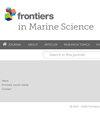Biogeographic variation in the impact of predation and secondary foundation species on the recruitment and growth of sessile mangrove prop root communities
IF 3
2区 生物学
Q1 MARINE & FRESHWATER BIOLOGY
引用次数: 0
Abstract
Predation and secondary foundation species play crucial roles in structuring sessile mangrove prop root communities. However, their relative importance and their interactions across biogeographic gradients remain poorly understood. This study investigated the impact of predation and secondary foundation species on mangrove prop root epibiont assemblages along a latitudinal gradient in Florida. Predator exclusion treatments were deployed at four sites spanning tropical to temperate zones, and community development was monitored over 6 months. The results showed that the effects of predation shifted with latitude, from increasing the species richness in the south while reducing it in the north. Secondary foundation species, such as sponges, oysters, and barnacles, generally outcompeted other species for space in the early colonization stages, but tended to increase biodiversity when space was not limiting. Secondary foundation species also exhibited context-dependent associations with species richness across the latitudinal gradient. Sponges and oysters tended to enhance the species richness under reduced predation pressure, while barnacles generally had negative effects at higher latitudes. The multivariate analyses revealed that the interaction between predation and latitude explained more variation in the community structure than predation alone, and secondary foundation species contributed significantly to these patterns. The findings support the predation hypothesis and facilitation by secondary foundation species in shaping mangrove prop root community shifts across biogeographic gradients, providing insights into the complex interactions structuring mangrove epibiont communities.捕食和次生基础物种对红树林支柱根群落补充和生长影响的生物地理变异
捕食和次生基础物种在红树林无根支柱根群落结构中起着至关重要的作用。然而,它们的相对重要性和它们在生物地理梯度上的相互作用仍然知之甚少。本文研究了捕食和次生基础物种对佛罗里达红树林支柱根表层生物群落的影响。在热带到温带的4个站点部署了捕食者排斥处理,并对社区发展进行了6个月的监测。结果表明,捕食的影响随纬度的变化而变化,从增加南方物种丰富度到减少北方物种丰富度。次生基础物种,如海绵、牡蛎和藤壶,在早期的定殖阶段通常比其他物种竞争空间,但在空间不受限制的情况下倾向于增加生物多样性。在整个纬度梯度上,次生基础种与物种丰富度也表现出环境依赖关系。在较低的捕食压力下,海绵和牡蛎倾向于增加物种丰富度,而藤壶在高纬度地区普遍具有负作用。多变量分析表明,捕食与纬度的相互作用比捕食对群落结构的影响更大,次生基础种对这些格局有重要影响。这些发现支持了捕食假说和次生基础物种在塑造红树林支柱根群落跨生物地理梯度变化中的促进作用,为红树林表层生物群落结构的复杂相互作用提供了洞见。
本文章由计算机程序翻译,如有差异,请以英文原文为准。
求助全文
约1分钟内获得全文
求助全文
来源期刊

Frontiers in Marine Science
Agricultural and Biological Sciences-Aquatic Science
CiteScore
5.10
自引率
16.20%
发文量
2443
审稿时长
14 weeks
期刊介绍:
Frontiers in Marine Science publishes rigorously peer-reviewed research that advances our understanding of all aspects of the environment, biology, ecosystem functioning and human interactions with the oceans. Field Chief Editor Carlos M. Duarte at King Abdullah University of Science and Technology Thuwal is supported by an outstanding Editorial Board of international researchers. This multidisciplinary open-access journal is at the forefront of disseminating and communicating scientific knowledge and impactful discoveries to researchers, academics, policy makers and the public worldwide.
With the human population predicted to reach 9 billion people by 2050, it is clear that traditional land resources will not suffice to meet the demand for food or energy, required to support high-quality livelihoods. As a result, the oceans are emerging as a source of untapped assets, with new innovative industries, such as aquaculture, marine biotechnology, marine energy and deep-sea mining growing rapidly under a new era characterized by rapid growth of a blue, ocean-based economy. The sustainability of the blue economy is closely dependent on our knowledge about how to mitigate the impacts of the multiple pressures on the ocean ecosystem associated with the increased scale and diversification of industry operations in the ocean and global human pressures on the environment. Therefore, Frontiers in Marine Science particularly welcomes the communication of research outcomes addressing ocean-based solutions for the emerging challenges, including improved forecasting and observational capacities, understanding biodiversity and ecosystem problems, locally and globally, effective management strategies to maintain ocean health, and an improved capacity to sustainably derive resources from the oceans.
 求助内容:
求助内容: 应助结果提醒方式:
应助结果提醒方式:


